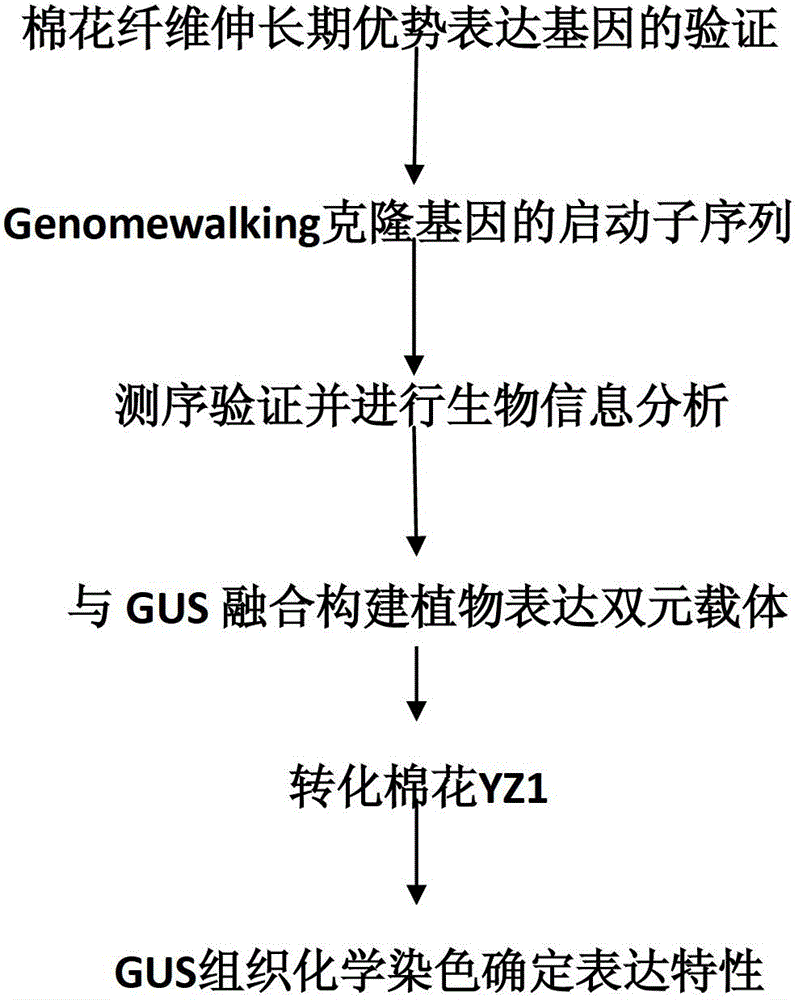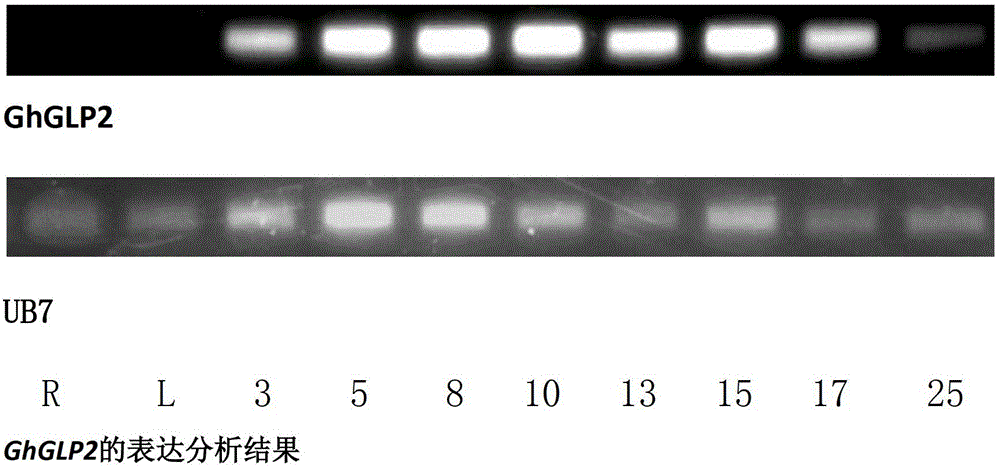A promoter predominantly expressed during fiber elongation, its preparation method and application
A technology of promoter and cotton fiber, applied in the field of plant genetic engineering
- Summary
- Abstract
- Description
- Claims
- Application Information
AI Technical Summary
Problems solved by technology
Method used
Image
Examples
Embodiment 1
[0096] Example 1: GhGLP2 and GbGLP3 expression analysis
[0097] The 3'-UTR of GhGLP2 and GbGLP3 was used to design primers for RT-PCR to verify their expression patterns. The DNA sequence of the primer is as follows:
[0098] GhGLP2Sense: 5'ACACTTTTTGCTGGTTTCATA 3'
[0099] GhGLP2Anti: 5'TAAACAAGGCAAAGTCCAGG 3'
[0100] GbGLP3Sense: 5'GACATTATGGTTTTCCCACG 3'
[0101] GbGLP3Anti: 5' TTTTTGCAATAACGCCAGTA 3'
[0102] The RT-PCR steps are as follows: Extract total RNA from different tissues: leaves, roots and 3, 5, 8, 10, 13, 15, 17, 23 DPA (days post anthesis) fibers of upland cotton TM-1; Fibers of 3, 5, 10, 15, and 20 DPA of sea-island cotton 3-79 and ovules on the day of flowering. After the RNA was extracted, it was treated with DNaseI (purchased from Promega), and the integrity of the RNA was detected by 1.4% (w / v) agarose gel (EtBr) electrophoresis (5V / cm). The determination of nucleic acid concentration was carried out on a Beckman DU800 spectrophotometer. The RNA ...
Embodiment 2
[0104] Example 2: Obtaining the sequences of promoters PGhGLP2 and PGbGLP3
[0105] Design GSP1 (gene special primer gene-specific primer) and GSP2 with the full-length cDNA 3' end sequence, using GenomeWalker TM The method of Universal Kit (Protocol No.PT3042-2, Clontech) was used to clone the promoter (see the kit operation manual for specific steps).
[0106] GhGLP2FGSP1: GGTCCTTTGTACTTCAGGTGCTATC
[0107] GhGLP2RGSP2: GTTTATGGCACTGGTTTTTGAGGG
[0108] GbGLP3FGSP1: GCAGGGGTTGAAGGCAGTTAGAC
[0109] GbGLP3RGSP2: GTTTATGGCACTGGTTTTTGAGGG
[0110] After gel electrophoresis, the target fragment was recovered with a gel recovery kit (Qiagene, Germany Cat. No. 28704), followed by TA cloning and sequencing. The two promoters are 1332bp and 641bp in length respectively, and an isolated promoter is obtained, whose sequence is the nucleotide sequence shown in SEQ ID NO: 1, and an isolated promoter whose sequence is SEQ ID NO: 2 Nucleotide sequences shown.
Embodiment 3
[0111] Embodiment 3: Promoter PGhGLP2 and PGbGLP3 drive GUS to express in cotton
[0112] Add BP adapters at both ends of the two promoters, and connect to pGWB433 using gateway's BP and LR technology (Imp roved gateway binary vectors: high-performance vectors for creation of fusion constructs in transgenic analysis of plants, 2007, Biosci biotechmol biochem) vector, transformed cotton line YZ1 to test whether it is a fiber-specific promoter. The primer sequences are as follows (reverse primers for both promoters are the same):
[0113] PGhGLP2F:5'GGGGACAAGTTTGTACAAAAAAGCAGGCTNNGGTCCTTTGTACTTCAGGTGCTATC'3
[0114] PGbGLP3F:5'GGGGACAAGTTTGTACAAAAAAAGCAGGCTNNGCAGGGGTTGAAGGCAGTTAGAC'3
[0115] PhGLPR: 5'GGGGACCACTTTGTACAAGAAAGCTGGGTN GTTTATGGCACTGGTTTTTGAGGG'3
[0116]The method used for the cotton transgene involved in the present invention is the genetic transformation method mediated by Agrobacterium. The Agrobacterium strain used is LBA4404, and the transformation receptor...
PUM
 Login to View More
Login to View More Abstract
Description
Claims
Application Information
 Login to View More
Login to View More - R&D
- Intellectual Property
- Life Sciences
- Materials
- Tech Scout
- Unparalleled Data Quality
- Higher Quality Content
- 60% Fewer Hallucinations
Browse by: Latest US Patents, China's latest patents, Technical Efficacy Thesaurus, Application Domain, Technology Topic, Popular Technical Reports.
© 2025 PatSnap. All rights reserved.Legal|Privacy policy|Modern Slavery Act Transparency Statement|Sitemap|About US| Contact US: help@patsnap.com



